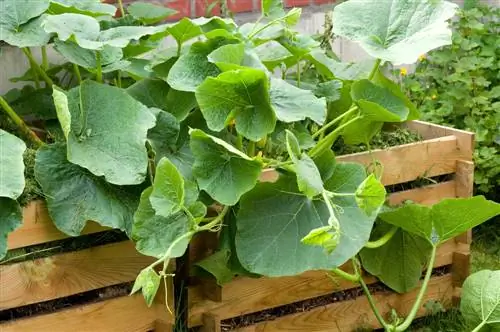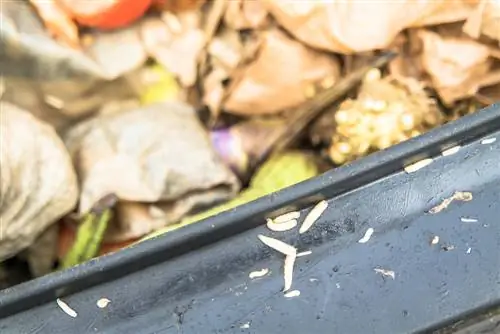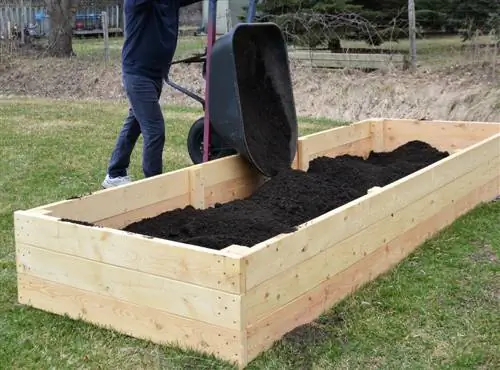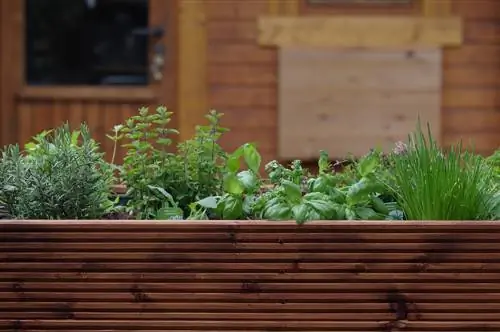- Author admin [email protected].
- Public 2023-12-16 16:46.
- Last modified 2025-01-23 11:21.
Raised beds are particularly productive (and of course practical) if you use them for composting at the same time. To do this, the boxes are filled according to the so-called hill bed principle and planted one after the other with vegetables with different nutritional requirements.

How does a raised bed work as compost?
A compost raised bed is a productive and practical bed in which the raised bed principle is applied: It is first filled with coarse wood waste, twigs, leaves, compost and garden soil and planted one after the other with strong, medium and weak feeders, whereby nutrients are used optimally.
How to Build a Compost Raised Bed
Since the material in such a compost raised bed collapses heavily due to the rotting process, it is best to construct the boxes as described:
- Use boards made from sturdy hardwoods.
- Oak, Douglas fir or larch wood are ideal.
- Place grooved posts in each corner.
- Insert the durable boards into these.
- These should be removable individually.
- This allows the height of the side walls to be adjusted to the constantly changing substrate height.
- No foil is used inside the bed box.
Don't forget the rabbit wire on the ground
For a raised bed with open ground, you should never forget the rabbit wire. It must be bent up at the edges and connected to the lowest boards without gaps using staples. Otherwise, voles and mice will soon live in the raised bed and attack your plants.
Fill the compost raised bed using the raised bed principle
In the classic way, a raised bed is filled with your own kitchen and garden waste using the raised bed principle. Within a few years, the entire material rots so badly that the plants are sometimes already deep in the box in the second year and hardly get any light. At the same time, the nutrient content changes from initially high to medium to weak. How quickly the rotting actually progresses depends on the structure, mixture and nitrogen content of the starting materials. You should make sure that you always have enough material available for refilling.
And this is what the individual layers of a “hill bed” raised bed look like:
- at the bottom coarse wood waste, densely layered and with chopped material to fill gaps
- above twigs and coarse shredded material
- as a third layer, rotted leaves or rotted manure or turned over lawn sod
- then coarse compost or raw compost
- as the last, top layer, garden soil or fine compost
Crop rotation on the compost raised bed
Compost raised beds are initially planted with heavy feeders in the first one to two years (depending on how much the bed has already collapsed). These include vegetables such as cabbage, celery, tomatoes, cucumbers, leeks, pumpkin, zucchini and sweet corn. From the second to third year onwards, vegetables follow that are no longer quite as hungry for nutrients. It is now optimal to plant with medium feeders such as chard, beetroot, lettuce, kohlrabi, Chinese cabbage, carrots, onions and garlic, potatoes, radishes, parsnips and spinach. From the third to fourth year onwards, the compost raised bed is perfect for weak eaters such as lamb's lettuce, winter purslane, rocket, radishes, beans, peas as well as parsley and other culinary herbs.
Tip
For good crop rotation, the plant family on the bed is changed every year. Green manure and soil cover during the winter months are also beneficial.






